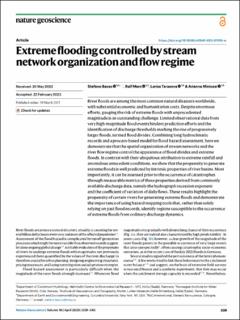| dc.contributor.author | Basso, Stefano | |
| dc.contributor.author | Merz, Ralf | |
| dc.contributor.author | Tarasova, Larisa | |
| dc.contributor.author | Miniussi, Arianna | |
| dc.date.accessioned | 2023-11-14T13:19:48Z | |
| dc.date.available | 2023-11-14T13:19:48Z | |
| dc.date.created | 2023-04-11T10:45:37Z | |
| dc.date.issued | 2023 | |
| dc.identifier.citation | Nature Geoscience. 2023, 16 (4), 339-343. | en_US |
| dc.identifier.issn | 1752-0894 | |
| dc.identifier.uri | https://hdl.handle.net/11250/3102491 | |
| dc.description.abstract | River floods are among the most common natural disasters worldwide, with substantial economic and humanitarian costs. Despite enormous efforts, gauging the risk of extreme floods with unprecedented magnitude is an outstanding challenge. Limited observational data from very high-magnitude flood events hinders prediction efforts and the identification of discharge thresholds marking the rise of progressively larger floods, termed flood divides. Combining long hydroclimatic records and a process-based model for flood hazard assessment, here we demonstrate that the spatial organization of stream networks and the river flow regime control the appearance of flood divides and extreme floods. In contrast with their ubiquitous attribution to extreme rainfall and anomalous antecedent conditions, we show that the propensity to generate extreme floods is well predicted by intrinsic properties of river basins. Most importantly, it can be assessed prior to the occurrence of catastrophes through measurable metrics of these properties derived from commonly available discharge data, namely the hydrograph recession exponent and the coefficient of variation of daily flows. These results highlight the propensity of certain rivers for generating extreme floods and demonstrate the importance of using hazard mapping tools that, rather than solely relying on past flood records, identify regions susceptible to the occurrence of extreme floods from ordinary discharge dynamics. | en_US |
| dc.language.iso | eng | en_US |
| dc.publisher | Nature | en_US |
| dc.rights | Navngivelse 4.0 Internasjonal | * |
| dc.rights.uri | http://creativecommons.org/licenses/by/4.0/deed.no | * |
| dc.title | Extreme flooding controlled by stream network organization and flow regime | en_US |
| dc.type | Peer reviewed | en_US |
| dc.type | Journal article | en_US |
| dc.description.version | publishedVersion | en_US |
| dc.rights.holder | © 2023 The Authors | en_US |
| dc.source.pagenumber | 339-343 | en_US |
| dc.source.volume | 16 | en_US |
| dc.source.journal | Nature Geoscience | en_US |
| dc.source.issue | 4 | en_US |
| dc.identifier.doi | 10.1038/s41561-023-01155-w | |
| dc.identifier.cristin | 2139874 | |
| cristin.ispublished | true | |
| cristin.fulltext | original | |
| cristin.qualitycode | 2 | |

